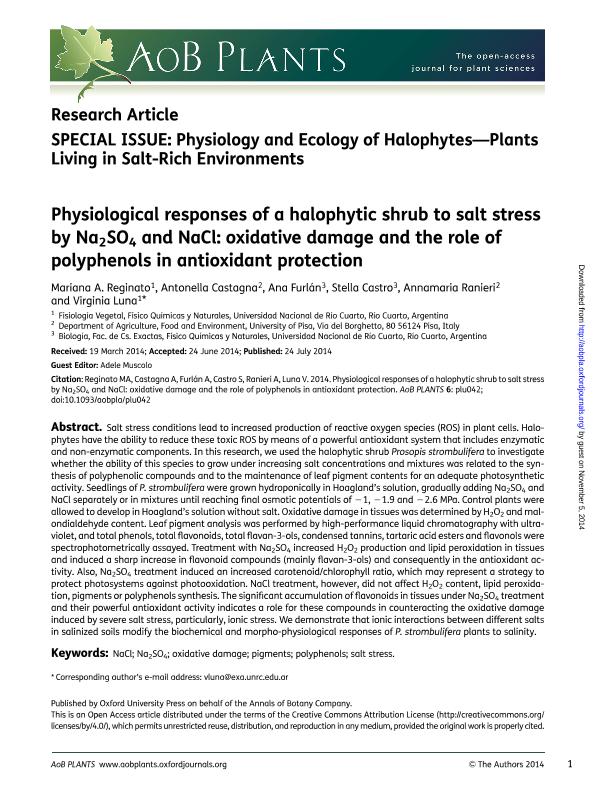Mostrar el registro sencillo del ítem
dc.contributor.author
Reginato, Mariana Andrea

dc.contributor.author
Castagna, Antonella
dc.contributor.author
Furlan, Ana Laura

dc.contributor.author
Castro, Stella Maris

dc.contributor.author
Ranieri, Annamaria
dc.contributor.author
Luna, Maria Virginia

dc.date.available
2018-01-18T14:14:37Z
dc.date.issued
2014-01
dc.identifier.citation
Reginato, Mariana Andrea; Castagna, Antonella; Furlan, Ana Laura; Castro, Stella Maris; Ranieri, Annamaria; et al.; Physiological responses of a halophytic shrub to salt stress by Na2SO4 and NaCl: oxidative damage and the role of polyphenols in antioxidant protection; Oxford University Press; AoB Plants; 6; 1; 1-2014; 1-13
dc.identifier.issn
2041-2851
dc.identifier.uri
http://hdl.handle.net/11336/33754
dc.description.abstract
Salt stress conditions lead to increased production of reactive oxygen species (ROS) in plant cells. Halophytes have the ability to reduce these toxic ROS by means of a powerful antioxidant system that includes enzymatic and non-enzymatic components. In this research, we used the halophytic shrub Prosopis strombulifera to investigate whether the ability of this species to grow under increasing salt concentrations and mixtures was related to the synthesis of polyphenolic compounds and to the maintenance of leaf pigment contents for an adequate photosynthetic activity. Seedlings of P. strombulifera were grown hydroponically in Hoagland's solution, gradually adding Na2SO4 and NaCl separately or in mixtures until reaching final osmotic potentials of −1, −1.9 and −2.6 MPa. Control plants were allowed to develop in Hoagland's solution without salt. Oxidative damage in tissues was determined by H2O2 and malondialdehyde content. Leaf pigment analysis was performed by high-performance liquid chromatography with ultraviolet, and total phenols, total flavonoids, total flavan-3-ols, condensed tannins, tartaric acid esters and flavonols were spectrophotometrically assayed. Treatment with Na2SO4 increased H2O2 production and lipid peroxidation in tissues and induced a sharp increase in flavonoid compounds (mainly flavan-3-ols) and consequently in the antioxidant activity. Also, Na2SO4 treatment induced an increased carotenoid/chlorophyll ratio, which may represent a strategy to protect photosystems against photooxidation. NaCl treatment, however, did not affect H2O2 content, lipid peroxidation, pigments or polyphenols synthesis. The significant accumulation of flavonoids in tissues under Na2SO4 treatment and their powerful antioxidant activity indicates a role for these compounds in counteracting the oxidative damage induced by severe salt stress, particularly, ionic stress. We demonstrate that ionic interactions between different salts in salinized soils modify the biochemical and morpho-physiological responses of P. strombulifera plants to salinity.
dc.format
application/pdf
dc.language.iso
eng
dc.publisher
Oxford University Press
dc.rights
info:eu-repo/semantics/openAccess
dc.rights.uri
https://creativecommons.org/licenses/by-nc-sa/2.5/ar/
dc.subject
Biochemistr
dc.subject
Stress
dc.subject
Whole-Plant Physiology
dc.subject
Physiology And Ecology of Halophytes
dc.subject
Plants Living in Salt
dc.subject
Rich Environments
dc.subject.classification
Otras Ciencias de la Tierra y relacionadas con el Medio Ambiente

dc.subject.classification
Ciencias de la Tierra y relacionadas con el Medio Ambiente

dc.subject.classification
CIENCIAS NATURALES Y EXACTAS

dc.title
Physiological responses of a halophytic shrub to salt stress by Na2SO4 and NaCl: oxidative damage and the role of polyphenols in antioxidant protection
dc.type
info:eu-repo/semantics/article
dc.type
info:ar-repo/semantics/artículo
dc.type
info:eu-repo/semantics/publishedVersion
dc.date.updated
2018-01-17T15:05:04Z
dc.journal.volume
6
dc.journal.number
1
dc.journal.pagination
1-13
dc.journal.pais
Reino Unido

dc.journal.ciudad
Oxford
dc.description.fil
Fil: Reginato, Mariana Andrea. Consejo Nacional de Investigaciones Científicas y Técnicas; Argentina. Universidad Nacional de Rio Cuarto. Facultad de Cs.exactas Fisicoquímicas y Naturales. Cátedra de Fisiología Vegetal; Argentina
dc.description.fil
Fil: Castagna, Antonella. Università degli Studi di Pisa; Italia
dc.description.fil
Fil: Furlan, Ana Laura. Universidad Nacional de Río Cuarto. Facultad de Ciencias Exactas Fisicoquímicas y Naturales; Argentina
dc.description.fil
Fil: Castro, Stella Maris. Universidad Nacional de Río Cuarto. Facultad de Ciencias Exactas Fisicoquímicas y Naturales; Argentina
dc.description.fil
Fil: Ranieri, Annamaria. Università degli Studi di Pisa; Italia
dc.description.fil
Fil: Luna, Maria Virginia. Universidad Nacional de Rio Cuarto. Facultad de Cs.exactas Fisicoquímicas y Naturales. Cátedra de Fisiología Vegetal; Argentina
dc.journal.title
AoB Plants
dc.relation.alternativeid
info:eu-repo/semantics/altIdentifier/doi/http://dx.doi.org/10.1093/aobpla/plu042
dc.relation.alternativeid
info:eu-repo/semantics/altIdentifier/url/https://academic.oup.com/aobpla/article/doi/10.1093/aobpla/plu042/2842726
Archivos asociados
